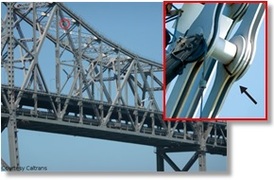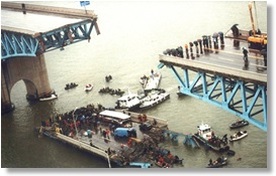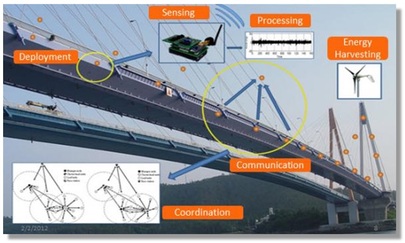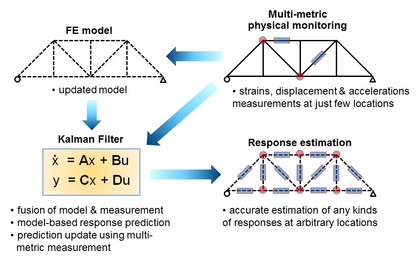|
Structural Health Monitoring
Declining conditions and performance of civil infrastructure, which would threat public safety, have been critical issues in most industrialized nations. The ability to assess the performance of such civil infrastructure in timely manner and detect damages at an early state can potentially reduce the costs as well as downtime associated with repairing and rehabilitating the systems, all while providing increased public safety. Visual inspection has been a current practice in monitoring the safety of civil infrastructure. However, high costs and unreliability often limit the use of visual inspection to infrequent occurrences. Structural health monitoring (SHM) methods that combines various sensing technologies with embedded measurements provides an essential tool to assess real states of our infrastructure. Smart Structure Systems Laboratory seeks to develop innovative ways our infrastructure is monitored, beyond traditional wired approaches. Currently, several research on the SHM are underway using wireless smart sensor networks (WSSN), particularly focusing on multi-metric hardware development, application software development for autonomous robust operation of WSSN, and new algorithms/strategies development tailored to SHM using WSSNs. Applications to other monitoring domains, such as mechanical/aerospace/naval/mining/energy systems, human-building interaction, and environment, are being explored. Application of advanced functional materials to new sensing technology developments are also of main research interests. |
** The U.S. Department of Transportation (US DOT 2010) has reported that $46.6 billion was used for rehabilitating highways and bridges and $11.0 billion for system enhancements in 2008, of which sum is about 63.2% of the total $91.1 billion capital outlay by all levels of government, while $33.6 billion (36.8%) was used for system expansion. Improving and modernizing the infrastructure is an important part of current government policy on ensuring homeland security and maintaining economic vitality. "63.2% budget for system management/maintenance/enhancement VS. 36.8% for system expansion"
|
Wireless Smart Sensor Networks
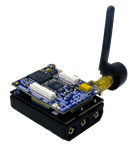 Imote2 platform Imote2 platform
Recent advanced sensor technologies have enabled SHM using wireless smart sensor networks (WSSNs), which is a promising alternative to the traditional wired SHM approaches. The smart sensors are typically small, inexpensive, and capable of wireless communication and onboard computation, addressing many of the concerns regarding wired monitoring. For example, easy installation and the associated reduction of installation cost, multi-hop communication, and decentralized in-network data processing are available with recent advances of WSSN; these attractive features enable the development of scalable monitoring systems and dense sensor networks.
Smart Structure Systems Laboratory uses Imote2 platform, developed by Intel (2006), for SHM research. It incorporates Intel's XScale microprocessor PXA271 having variable speed of 13~412MHz, 256Kb RAM, 32Mb SDRAM, 32Mb Flash, Power management IC, and 802.15.4 radio; which provide a lot more memory and faster process than other many academic or commercial platforms at reasonable power consumption (44mW). Dr. Hongki Jo has developed various sensor boards (SHM-H, SHM-P, SHM-S, SHM-DAQ, SHM-control, and SHM-DAQ24 boards) to be used with Imote2 for SHM applications during his PhD study, more than 350 of those sensorboards are being used by many research institutes over the world. |
As an international collaborative research project between US, Korea, and Japan for full-scale long-term deployment of Imote2 WSSN, Jindo bridge WSSN constitutes the world's largest WSSN for civil infrastructure monitoring to date. Dr. Hongki Jo led the project on the US side in hardware development and field deployment.
|
|
Hybrid Monitoring Systems
|
No matter how hard we try, identifying all potential damage locations is not possible. The WSSN technologies allow denser deployment of sensor, but the number of sensors deployed on structures is still finite. The goal of the hybrid monitoring system is to allow us to determine any kind of structural response at arbitrary locations using limited sensor information.
In Smart Structure Systems Laboratory, hybrid approach is being explored, fusing numerical modeling and physical monitoring. Structural responses are predicted for entire structural members using numerical models, then the predicted responses are updated using just few physical measurements. Particularly, this research focus on the use of multi-metric measurements to enhance the accuracy of the response estimations. Such a hybrid method has been numerically validated, experimental validations are underway both in lab and full scale. "Less number of sensors, but better monitoring quality" |
Applications of the hybrid approach are not limited to just structural health monitoring. As long as numerical models of systems or phenomenon are available, the accuracy of models' outputs can be significantly enhanced by fusing real measurements at various metric, even with limited numbers of sensors. Possible applications include, but not limited to; model-based hybrid scour monitoring, hybrid traffic monitoring, hybrid air/water quality monitoring, hybrid land-slide monitoring, and so on.
|
Wind-induced behavior of Cable-supported Bridges
As wind is one of the most critical loadings in long-span cable-supported bridges. understanding the wind-induced movements of the bridges is very important. While many numerical approaches and lab-scale wind-tunnel methods exist, but methods for full-scale testing of real structure are not readily available due to difficulties in wind-pressure sensors installation on structures.
Harbin Institute of Technology (China, Prof. Hui Li) is leading the Xihoumen Bridge project, in collaboration with University of Illinois at Urbana-Champaign (Prof. B.F Spencer, Jr.), to figure out the buffeting vibration due to strong wind and vortex-induced vibration on the double-deck system at low-speed wind of the bridge using WSSN. Dr. Hongki Jo is participating the project to provide the smart sensor framework for wireless wind pressure measurement. SHM-P, SHM-H, SHM-DAQ, and SHM-S boards that Dr. Hongki Jo developed are used for this project. |
|
Bio-inpired sonar sensing for scour monitoring
This collaborative research project (with Dr. Jennifer Duan) aims to investigate the feasibility of densely arrayed low-cost sonar sensors for real-time scour topography monitoring around bridge piers, mimicking electric fishes' skin sensing strategies, and enhance a two-dimensional unsteady flow hydrodynamic and sediment transport model to predict the impacts on structures, including drag forces and scour depth, from highly-convective flood waves.
|
Mimicking biological signal processing strategies has tremendous potential for improving the quality of sensor information. For example, certain freshwater fishes in South America and Africa, so called weakly electric fish, generate electric field to actively probe their environment and detect voltage perturbations arising from nearby objects in the water (Nelson 2012). The body of a weakly electric fish is covered with around 15,000 electroreceptors; however, each individual electroreceptor is a relatively low-resolution sensor and does not provide reliable event detection. To compensate for this, the nervous system of the electric fish implements several smart signal processing like adaptive gain control, multi-scale filtering, reafference suppression and common mode rejection. Even with low-resolution electroreceptors, the dense sensor array and smart processing allow the fishes to be able to successfully detect and localize targets in 3D space. This suggests the possibility of bio-inspired sonar sensing strategy that achieves high-precision scour topography monitoring using a dense array of low-cost sonar sensors.
|

